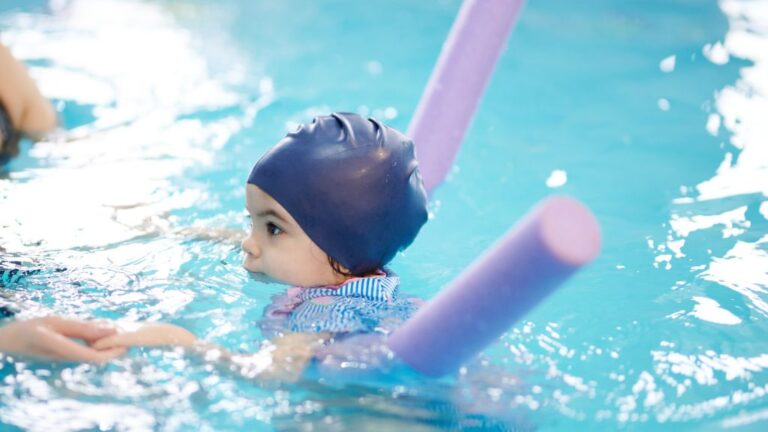With summer quickly approaching, the glimmer of backyard swimming pools or days spent at the beach with family grow closer and closer. During the summer season, pool safety for kids with autism is more critical than ever. ABA Centers of Florida understand that kids with autism spectrum disorder (ASD) are fascinated with large bodies of water for various reasons.
While water can be fantastic for autism development, play, exploration, and sensory exposure, parents and providers shouldn’t overlook the dangers it can pose. Understanding the unique needs and challenges that ASD can bring into every environment, including water, is crucial to prevent accidents and promote safety.
Unfortunately, over the last decade, there have been tragedies related to children with ASD and water that have brought our understanding of ASD water dangers to new heights. Autism advocates are eager to share information to prevent injuries and fatalities this and every summer within the neurodivergent community. Sadly, drowning remains one of the most prominent causes of mortality in individuals with ASD.
By considering sensory sensitivities, behavioral tendencies, and communication barriers, parents and caregivers can equip themselves with the tools and knowledge needed to make pool time and splashing around a positive experience for kids with ASD.
An important aspect of our ABA care services includes providing essential resources to the community, like this guide to pool safety for kids with autism. We hope this blog post offers helpful tips and insight from ABA experts to ensure your kids stay safe this summer while having some seriously epic fun!
Let’s dive into pool safety with an informed, intelligent, and optimistic outlook and allow our children to enjoy water activities with peace of mind.
Why Pool Safety Matters
As parents, we always want our children to have incredible fun and enjoy life to the fullest. When our kids have ASD, we recognize they face specific challenges, but we don’t want to keep them from experiencing some of life’s best things, like fun in the water!
Many recognize the summer as a time to take advantage of nature, outdoor sports, and swimming pools. However, when it comes to activities that could be dangerous under certain circumstances, safety should always be a top priority, especially for those with ASD.
Every child is different, and with that insight, it’s essential to personalize these tips and information in a way most relevant to your current experiences. But ultimately, it’s most vital to consider that individuals of all ages with ASD have characteristics that often make them more vulnerable around water. While awareness is essential, there are simple steps that autism parents and caregivers can take to ensure pool safety for kids with autism.
Children with ASD Are at Higher Risk of Drowning
Many don’t realize that children with ASD are at a higher risk of drowning than other children. Research shows that children with ASD are 160 times more inclined to drown than their neurotypical peers. This vulnerability is often because individuals with ASD have trouble with sensory processing and communication and can tend to engage in repetitive behaviors.
These features can make it harder to detect when they are intaking water or even in danger. Additionally, repetitive behaviors can increase panic and make it harder to swim or float. But the terrific news is that parents can implement various strategies and safety measures to reduce the risk of drowning in ASD. ABA therapy is an approach many consider to help manage features of ASD that can make everyday life harder, including experiences with water.
What is ABA Therapy?
Applied Behavior Analysis, commonly called ABA therapy, is a scientifically validated treatment approach for children with ASD. ABA therapy teaches skills necessary for daily functioning and independence and helps reduce problematic behaviors. ABA breaks tasks into manageable steps and uses positive reinforcement techniques to promote skill development.
For kids with ASD, ABA therapy can be essential in helping them learn to communicate danger and cognitive skills that will benefit them in new settings. With intensive and high-quality ABA treatment, kids with ASD can learn critical skills and gain more autonomy, often leading to a higher quality of life for them and their families.
ABA Therapy Can Promote Pool Safety for Kids with Autism
Regarding pool safety, ABA therapy can teach children water safety skills and risk awareness to help prevent drowning. Registered Behavior Technicians (RBTs) and Board Certified Behavior analysts (BCBAs) may use visual aids and simulations to teach children how to respond in different water emergencies, recognize important cues, or manage expectations.
In an ABA session that supports water safety, a child might first learn to wear a life jacket, then how to enter a pool slowly and carefully. Clients may learn swimming strokes while maintaining physical contact with the pool wall or a lifeguard. If the client needs extra support, the RBT may even begin practice in a bathtub or kiddy pool. ABA providers will always accommodate the environment when designing plans, considering all details surrounding the intervention.
Additionally, RBTs may use repetition and continual reinforcement to teach children to stay near their parents or providers in the pool, wear approved gear, and respond to warnings about the water’s depth. Additionally, clients learn how to react if they fall in the water. ABA therapists can further help address anxiety or sensory sensitivities around water to build comfort around the setting.
With practice and consistency, children can learn to follow pool rules, swim to safety, get attention in a crisis, and gain lifesaving skills to give them more freedom and confidence around pools while maintaining their security. ABA therapy takes a customized, client-centered approach to help each kiddo reach their full potential. ABA understands that kids with ASD typically begin a range of previous experiences, which BCBAs always consider in their plans.
Pool Safety Tips for ASD
When a child with ASD is near a pool, we strongly recommend US Coast Guard-approved life jackets or other floatation devices. Also, set up clear barriers or fences around the pool area and keep all gates closed and locked when not being used. For kids drawn to the water, always supervise them and maintain a phone nearby in case of emergencies. Swimming lessons tailored for children on the spectrum can teach water skills and may be an excellent option for many.
Get Ready for Your Best, Safest Summer Yet!
Autism doesn’t have to be the reason for dreading summer. It can be an opportunity for new adventures and experiences. Parents must take reasonable steps and take wise precautions to ensure a safe pool experience, which can also be part of the fun. By accepting these extra steps and forging joyous memories around water safety, parents can give their developmentally unique children a summer they’ll never forget!
More About ABA Centers of Florida
Thankfully, ABA therapy offers parents and children increased oversight and strategies to make time in the pool safer and more enjoyable. While ABA therapy doesn’t always focus on pool safety, our team always considers your family\’s passions and lifestyle.
ABA Centers of Florida hopes that all children will have a safe and positive summer in the pool and that parents can find comfort in knowing they are doing everything possible for their kids. If your suspect your child may be on the spectrum or think your neurodivergent child may need some ABA support this summer, don’t wait to call.
With concrete guidelines and an expert comprehension of your child\’s abilities and dreams, we make things better.
Call us at (772) 773-1975 or click here.








